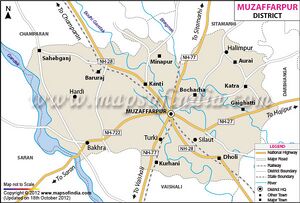Muzaffarpur

Muzaffarpur (मुजफ्फरपुर) is a city and district in Bajjikanchal region of Bihar.
Location
It is situated on the banks of the perennial Burhi Gandak River, which flows from the Someshwar Hills of Himalayas. Muzaffarpur is one of the many gateways to Nepal. Muzaffarpur is located at 26°07′N 85°24′E.
Origin of name
Muzaffarpur City was established by and named after an Afghan Md. Muzaffar Khan, an Amil (Revenue Officer).
History
The history of the district dates back to the rise of the Vrijjan Republic, when the center of political power shifted from Mithila to Vaishali. The Vrijjan Republic was a confederation of eight clans of which the Licchavis were the most powerful and influential. Even the powerful kingdom of Magadh had to conclude matrimonial alliances in 519 B.C. with the neighbouring estates of the Licchavis. Ajatshatru invaded Vaishali and extended his sway over Tirhut. It was at this time that Pataliputra (the modern Patna) was founded at the village Patali on the banks of the sacred Ganges river, and Ajatshatru built an invincible fortress to keep vigil over the Licchavis on the other side of the river.
Ambarati, 40 km from Muzaffarpur is believed to be the village home of Amrapali, the famous Royal court dancer of Vaishali.
From the visit of the Hieuen Tsang until the rise of the Pala dynasty, Muzaffarpur was under the control of Maharaja Harsha Vardhan, a powerful sovereign of North India. After 647 A.D. the district passed to the local chiefs.
In the 8th century A.D. the Pala kings gained control over Tirhut and kept it until 1019 A.D. The sixty-sixth descendents of the Palas are the Pauls in Muzaffarpur. Samiran Kumar Paul, the eminent scholar, teacher and Poet is one of them. Chedi kings of Central India also exercised their influence over Tirhut until they were replaced by the rulers of the Sena dynasty towards the close of the 11th century.
Sometime between 1211 and 1226, Ghais-u-ddin Iwaz, the ruler of Bengal, became the first Muslim invader of Tirhut. However, he could not succeed in conquering the kingdom, merely extorting tributes. It was in 1323 that Ghiyasuddin Tughlaq established his control over the district.
The history of Muzaffarpur would be incomplete without a reference to the Simraon dynasty (in the north-east part of Champaran) and its founder, Nanyupa Deva, who extended his power over the whole of Mithila and Nepal. During the regime of Harasimha Deva, the last king of the dynasty, Tughlaq Shah invaded Tirhut in 1323 and gained control over the territory. Tughlaq Shah handed over the management of Tirhut to Kameshwar Thakur. Thus, the sovereign power of Tirhut passed from the Hindu chiefs to the Muslims.

